11 inspiring sales funnel examples to boost your business growth
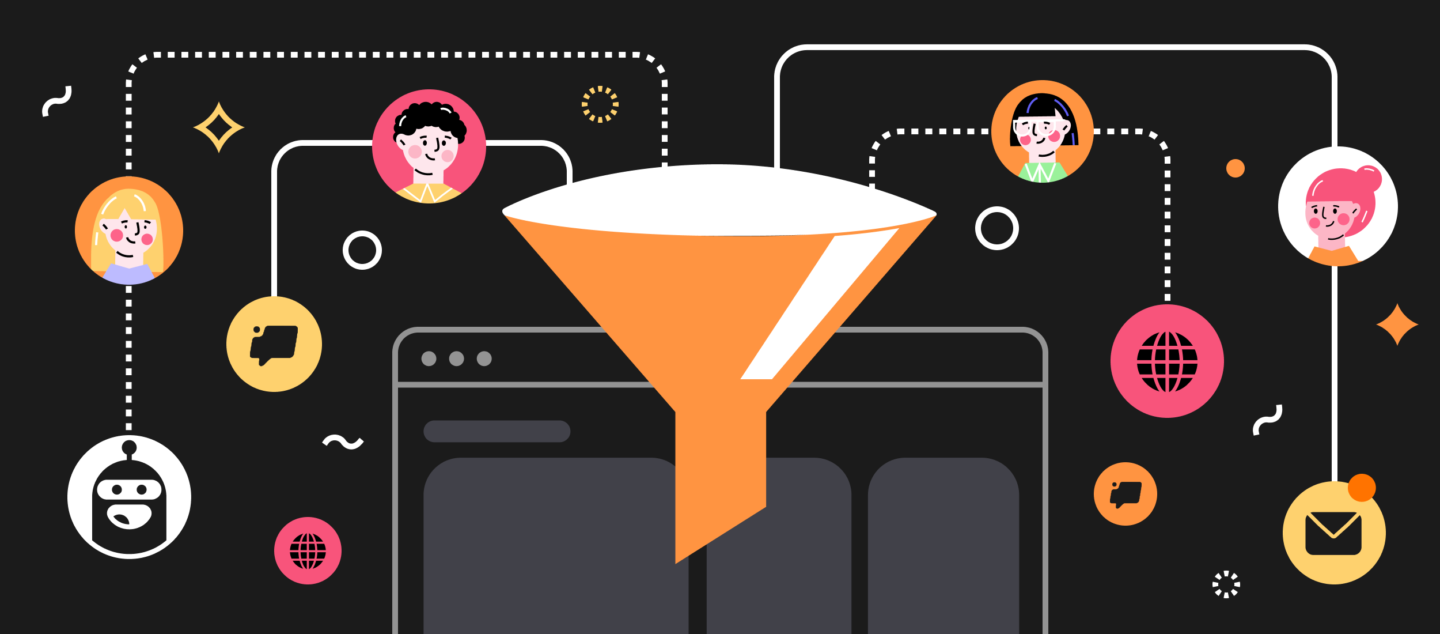
Struggle to find a way to fix a leaky funnel, improve leads’ quality or boost sales? It’s time to work on your funnel. And you came to the right place! This article will give you inspiration and new ideas, showcasing 10 top-notch sales funnel examples from SaaS companies.
So let’s dive in to find the best-matching examples to spark your next funnel experiment. Buckle up!
Sales funnel examples of Hubspot
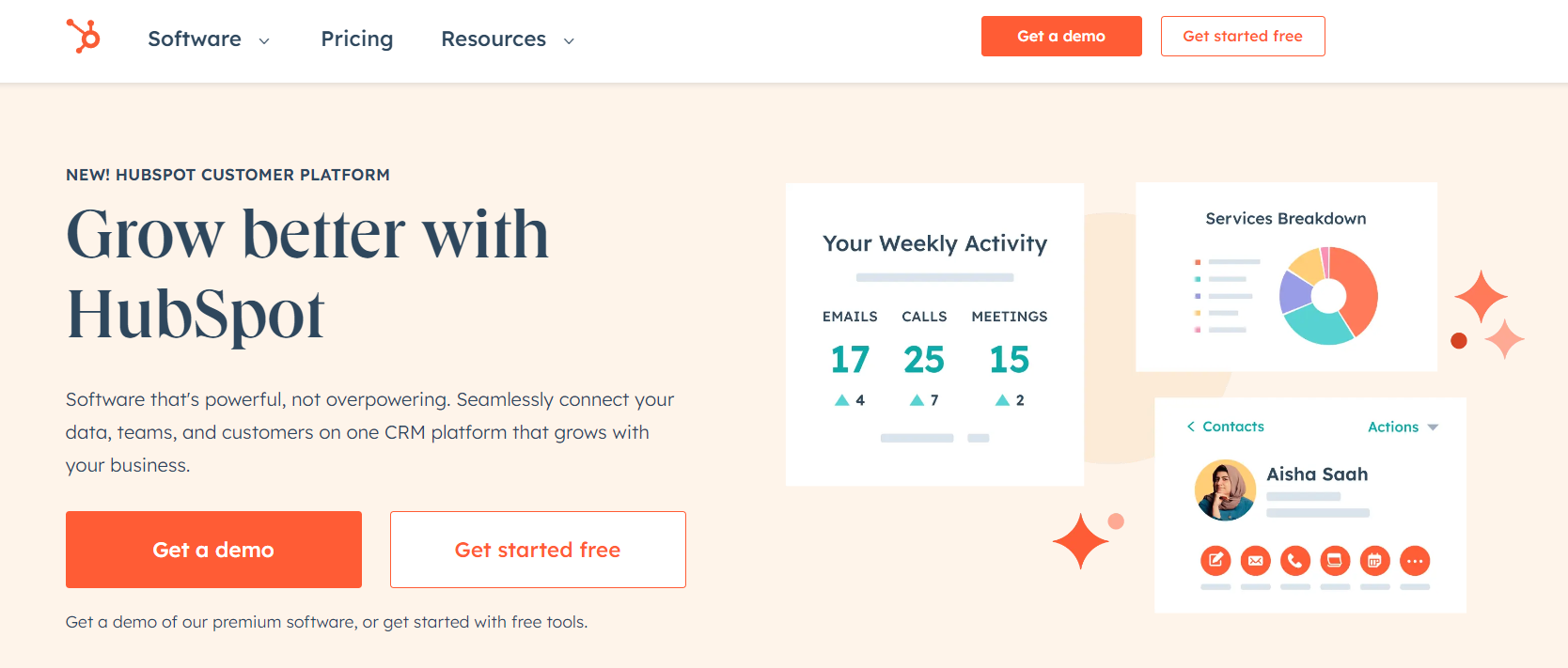
First in line is HubSpot, a well-known player in the inbound marketing game. HubSpot offers a comprehensive suite of software products that empower companies to grow through effective inbound marketing, sales, and customer service strategies.
Highly acknowledged in the industry, HubSpot serves as a great example for SaaS companies looking to optimize their sales funnel. Known for their deep expertise in drawing in and nurturing leads.
Let’s dive in and dissect this funnel example to find out what you can borrow for your strategy.
Funnel steps
- Awareness through comprehensive content: HubSpot is the king of content marketing. They attract leads through high-quality, free resources like blogs, eBooks, webinars, etc. Their content addresses customer pain points, ranks high on Google, and drives significant organic traffic to their site. Google any marketing or sales issue — Hubspot will have an article for it. That’s a good inbound example on how to capture visitors’ attention and gradually grow their interest.
- Lead capture via valuable offers: Once on the website, visitors are met with opportunities to sign up for free tools, trials, or downloadable content. HubSpot’s landing pages set a great example on how to convert visitors into leads by exchanging valuable information for contact details.
- Nurturing with tailored email sequences: After capturing leads, HubSpot nurtures them through personalized email sequences designed to engage and educate. At this stage, the team sends targeted content that addresses specific needs, gradually guiding prospects down the sales funnel by demonstrating how HubSpot can meet those needs.
- Conversion through a freemium model: A pivotal sales funnel HubSpot strategy is their freemium model. When you allow potential customers to use basic features for free, you let them see the product’s value, making it easier to upsell once the user sees the benefits firsthand. Once again, it’s a value-first model.
- Engagement and upselling via webinars: HubSpot leverages webinar sales funnels to engage users further. These sessions offer in-depth insights into their products and services, helping to move prospects down the funnel and driving conversions by sharing relevant successful examples of customer stories.
- Social proof and testimonials: Throughout the funnel, HubSpot builds trust via social proof. Online testimonials, case studies, and customer success stories reinforce the credibility and effectiveness of their solutions.
- Closing with customized offers: As prospects reach the decision stage, HubSpot offers tailored offers, discounts, or limited-time promotions (a bit of time pressure can be helpful, just don’t overdo it) to convert them into paying customers. Each step is carefully designed to make the buying decision as seamless and informed as possible.
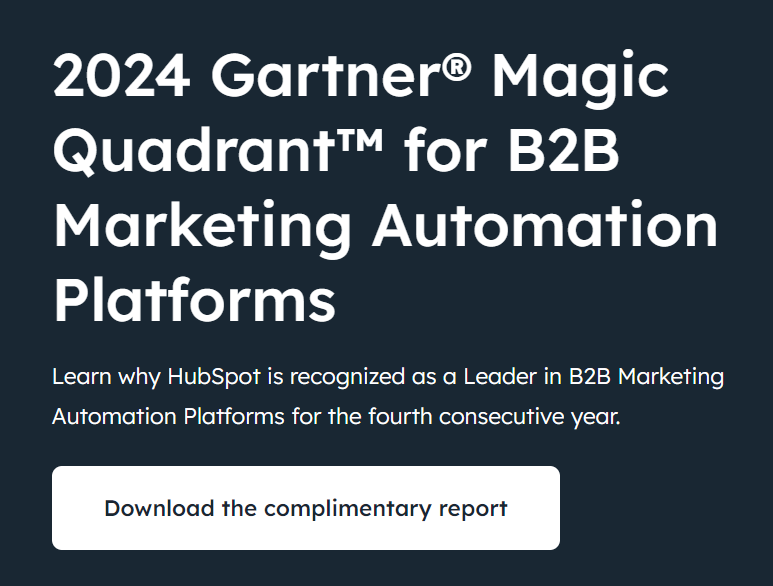
Why this is one of the best sales funnel examples
HubSpot’s sales funnel provides plenty of insights for anyone looking to refine their own sales journey.
One key lesson is the power of quality content. And you’ll see it further in our other examples! HubSpot’s extensive library of blogs, eBooks, and webinars serves as a magnet for potential leads. THe team puts a lot of effort into SEO, addressing diverse pain points in inbound marketing, which spreads awareness about the brand and establishes HubSpot as a thought leader in the industry.
The design of HubSpot’s landing pages is another crucial takeaway. Each page is crafted to maximize conversion by offering clear, action-oriented CTAs and ensuring the content is relevant to the visitor’s needs. This focus on lead capture efficiency is exemplified by their strategic use of free tools and trials, which lower entry barriers and give visitors an incentive to provide their contact details. So remember, value first.
Personalization is at the core of their lead nurturing strategy. By tailoring email content to address specific prospect needs and interests, HubSpot effectively moves leads down the funnel while keeping them informed and engaged. This individualized approach ensures that communications remain relevant and helpful, enhancing the overall user experience.
The freemium model stands out as a pivotal sales funnel example. Allowing users to experience the value of a product without upfront commitment dramatically increases the likelihood of conversion. Once users recognize the benefits, they’re more inclined to upgrade to paid plans, providing a seamless transition from prospect to customer.
HubSpot’s use of webinars as a tool for engagement and upselling. By offering detailed product demos and successful customer stories, webinar sales funnels serve as an effective method for building trust and user engagement. Complemented by powerful social proof elements, webinars also show the tangible benefits of HubSpot’s solutions. Additionally, it’s another component for creating a reputation as an industry thought leader.
In summary, HubSpot’s sales funnel is an exceptional inbound example that combines content, personalization, freemium offerings, and social proof.
Their approach highlights the importance of a well-structured, customer-focused sales funnel that keeps prospects engaged and drives them towards conversion.
By incorporating these strategies into your own sales funnel, you can create a seamless and rewarding journey that captivates and retains customers.
Sales funnel of Salesforce
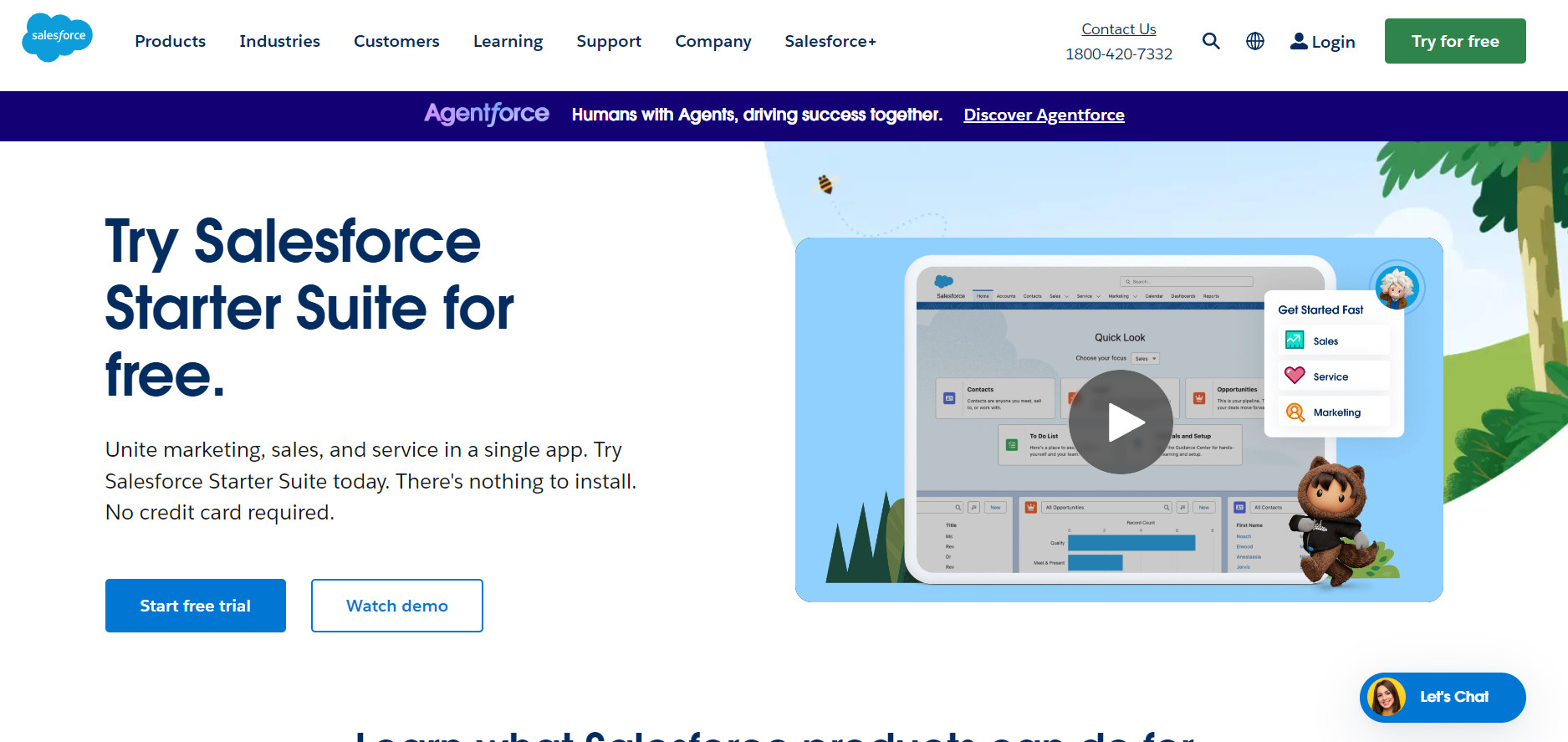
Enter Salesforce, a renowned customer relationship management (CRM) software. It’s a robust platform that empowers businesses to streamline and enhance their sales processes.
Offering a comprehensive suite of cloud-based applications for sales, service, marketing, analytics, and more, Salesforce stands as a highly acknowledged company within the industry.
This company is an inspiring sales funnel example for businesses aiming to optimize their sales operations.
Let’s delve into the strategic steps that make Salesforce’s approach one of the best sales funnel examples.
Funnel steps
- Attract through brand authority and SEO: Salesforce leverages its strong brand authority and an effective SEO strategy to draw in potential leads. It’s done with thought leadership content, such as whitepapers, blogs, podcasts, and webinars. Lead magnets and optimized articles help engage audience and drive organic traffic to their website.
- Engage with detailed product pages and use cases: When a visitor goes down the content funnel, they are met with detailed product pages that expand on specific features, benefits, and use cases. The main goal of these pages is to explain how Salesforce can resolve prospects’ specific issues. The use of customer testimonials and success stories adds another layer of credibility and trust.
- Capture leads through free trials and demos: Salesforce encourages prospective customers to convert by offering free trials. By giving users a firsthand experience of their platform, Salesforce allows prospects to explore features without financial commitment, thereby increasing the likelihood of conversion. It also offers pre-recorded demos to share the benefits of the platform.
- Nurture with tailored follow-ups and content: After capturing leads, Salesforce employs personalized follow-ups to nurture prospects. Through targeted emails and curated content, they address specific pain points and demonstrate how Salesforce solutions can meet those needs, staying on users’ radar and keeping them in the funnell.
- Convert with customized solutions and pricing plans: As prospects advance towards a purchase decision, Salesforce offers tailored solutions and flexible pricing plans. This customization ensures that the offerings align with the unique needs and budgets of each customer, facilitating a smooth and informed purchase process.
- Reinforce with community resources and support: As a part of their sales funnel, Salesforce provides extensive resources and support through their Trailblazer Community, help centers, and ongoing training programs. This keep-in-touch strategy reinforces their value proposition and encourages long-term loyalty.
Key takeaways for your sales
Salesforce’s sales funnel is a comprehensive lifecycle engagement model that offers several valuable takeaways.
First, leveraging brand authority through diverse content channels is crucial. Salesforce’s emphasis on SEO and high-quality thought leadership content establishes them as a trusted resource in CRM, drawing organic traffic and engaging potential leads.
As a tip: try to distribute your content beyond your website. Leverage your social media, other content platforms (e.g. Medium) to expand your reach.
Pay attention to detailed product pages and use cases. By providing thorough explanations and clear examples of how the platform solves specific business problems, Salesforce effectively educates prospects and builds confidence.
The integration of customer testimonials further strengthens credibility, making these pages instrumental in guiding prospects through the funnel.
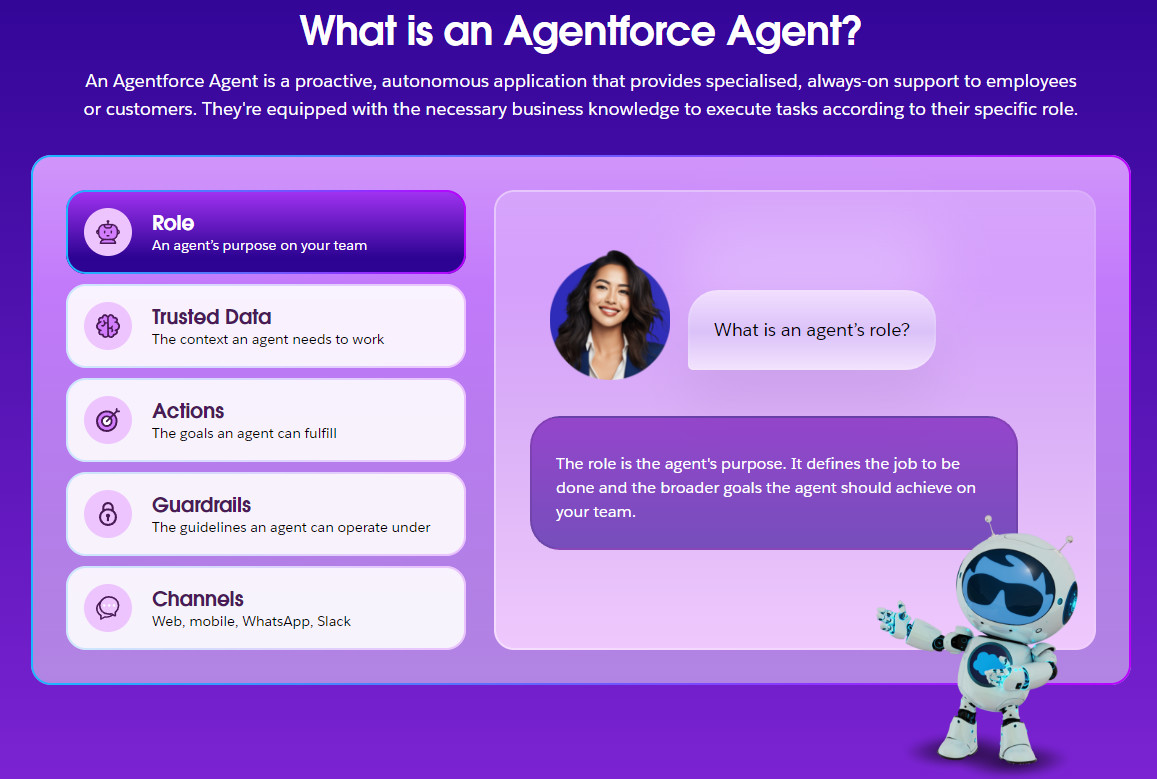
Offering free trials and demos is central to Salesforce’s conversion strategy. By allowing potential customers to test the platform’s capabilities without financial risk, Salesforce lowers the barrier to entry and enhances user understanding. The hands-on experience is critical for further decision-making that can speed up the buying process.
Personalized follow-ups are a key component of the nurturing process. Similar to Hubspot, Salesforce’s tailored communications demonstrate an understanding of each prospect’s unique challenges, offering solutions that highlight the platform’s relevance and value.
Customization in solutions and pricing plans underscores the sales funnel Salesforce strategy. By adapting offerings to fit the diverse needs of businesses, Salesforce enhances the appeal and accessibility of their solutions, facilitating smoother sales conversions.
Invest in high-quality customer support and community engagement. It will become a cornerstone of your retention strategy. By providing extensive resources, training, and community interaction opportunities, Salesforce fosters a sense of belonging and encourages ongoing exploration of their offerings, strengthening customer loyalty. And it works.
Salesforce’s sales funnel serves as an exemplary model in the best sales funnel examples, combining brand authority, educational engagement, and personalized nurturing to drive success.
By integrating these components into your own sales funnel, you can create a compelling journey that attracts, engages, and retains customers. The Salesforce way is about robust engagement, tailored solutions, and ongoing support — a winning combination for any successful funnel.
Sales funnel of Dashly
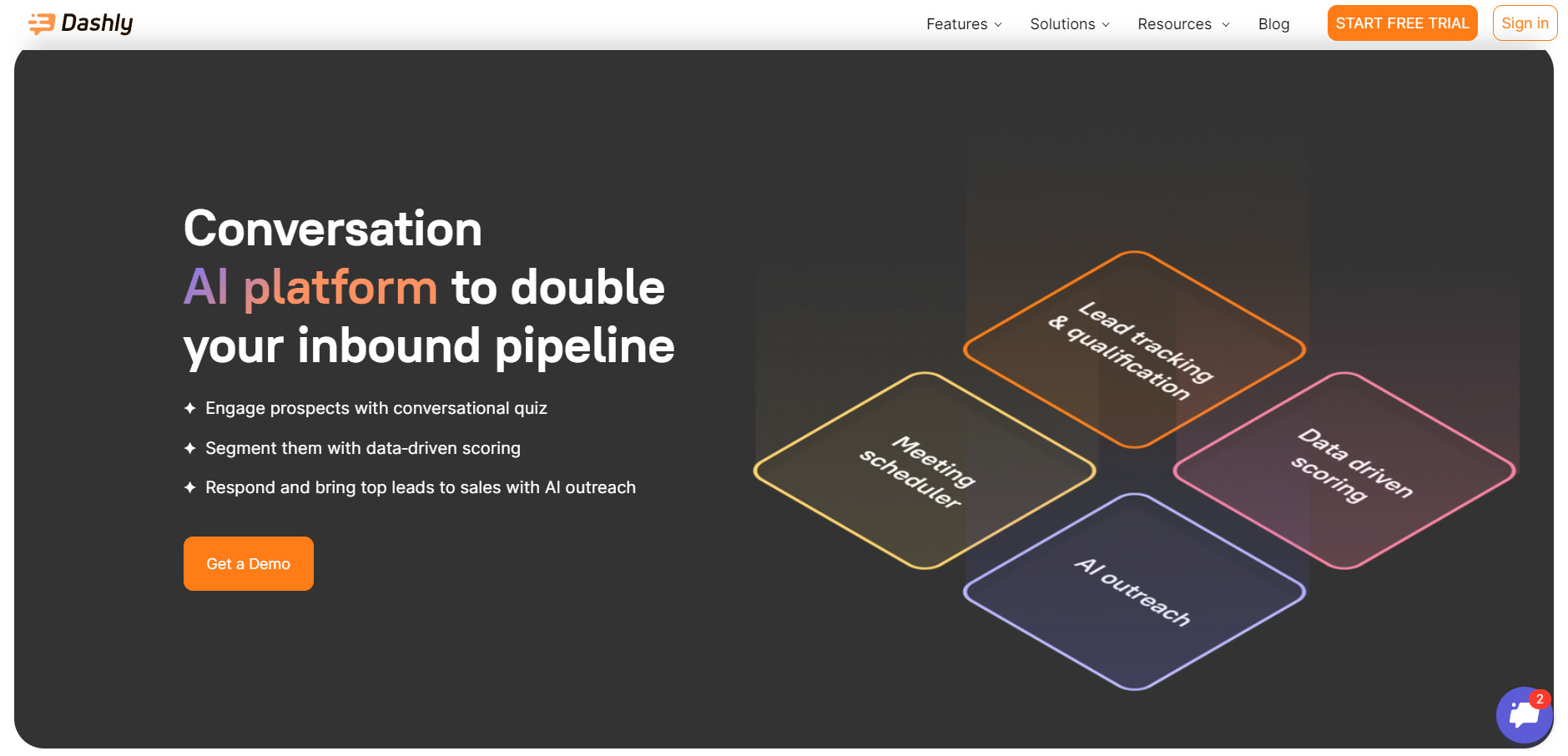
Meet Dashly, a Conversation AI platform that transforms how businesses interact with leads to double their inbound pipeline. Dashly redefines lead communication with its AI-powered sales assistant, designed to handle inquiries and guide prospects towards booking meetings with sales reps.
By changing the dynamics of sales interaction, Dashly offers a cutting-edge solution that enhances lead engagement and conversion rates. Let’s explore how Dashly exemplifies an innovative sales funnel example and their approach to effective inbound example practices.
Funnel steps
- Awareness through SEO and social media: Dashly draws attention and potential leads primarily through an effective SEO strategy and a strong social media presence, particularly on LinkedIn. By creating valuable content and engaging with audiences online, Dashly ensures a steady flow of organic traffic to its website, capturing the interest of businesses looking to enhance their sales processes.
- Lead capture and qualification with a quiz bot: Once visitors arrive on the website, Dashly employs a quiz bot to capture and qualify leads. The bot asks targeted questions to understand the lead’s pain points and requirements, allowing Dashly to tailor a personalized offer. This deep insight into lead needs ensures that the solution offered is both relevant and compelling.
- Engagement with AI-powered sales assistant: Dashly’s AI-powered sales assistant engages prospects by addressing their inquiries and guiding them towards booking a meeting with a sales rep. This intelligent interaction not only saves time but also enhances the customer experience by providing immediate and accurate responses.
- Personalized nurturing with AI-driven emails: After a meeting is booked, Dashly uses its AI capabilities to craft personalized email sequences. Based on the lead’s quiz answers, these emails nurture prospects by providing value and keeping them engaged until the scheduled meeting. This targeted communication helps maintain interest and ensures a smooth transition to the next stage in the sales funnel.
Why this example works
Dashly’s approach to funnel management highlights the transformative power of AI in modern sales.
First, investing in SEO and building a strong social media presence are essential for driving awareness and attracting potential leads. By leveraging these channels effectively, Dashly ensures consistent engagement with its target audience.
Lead qualification using a quiz bot is another strategic step that Dashly excels in. By gathering detailed information about prospects, Dashly can tailor offers that are highly relevant to the individual’s needs, increasing the chances of conversion. This approach demonstrates the importance of understanding lead pain points to offer customized solutions.
The use of an AI-powered sales assistant is a game-changer in Dashly’s sales funnel example. By handling routine inquiries and streamlining the booking process, the AI assistant both enhances efficiency and improves the overall customer experience. This illustrates how automation can effectively handle a significant portion of sales tasks, allowing human teams to focus on more strategic interactions.
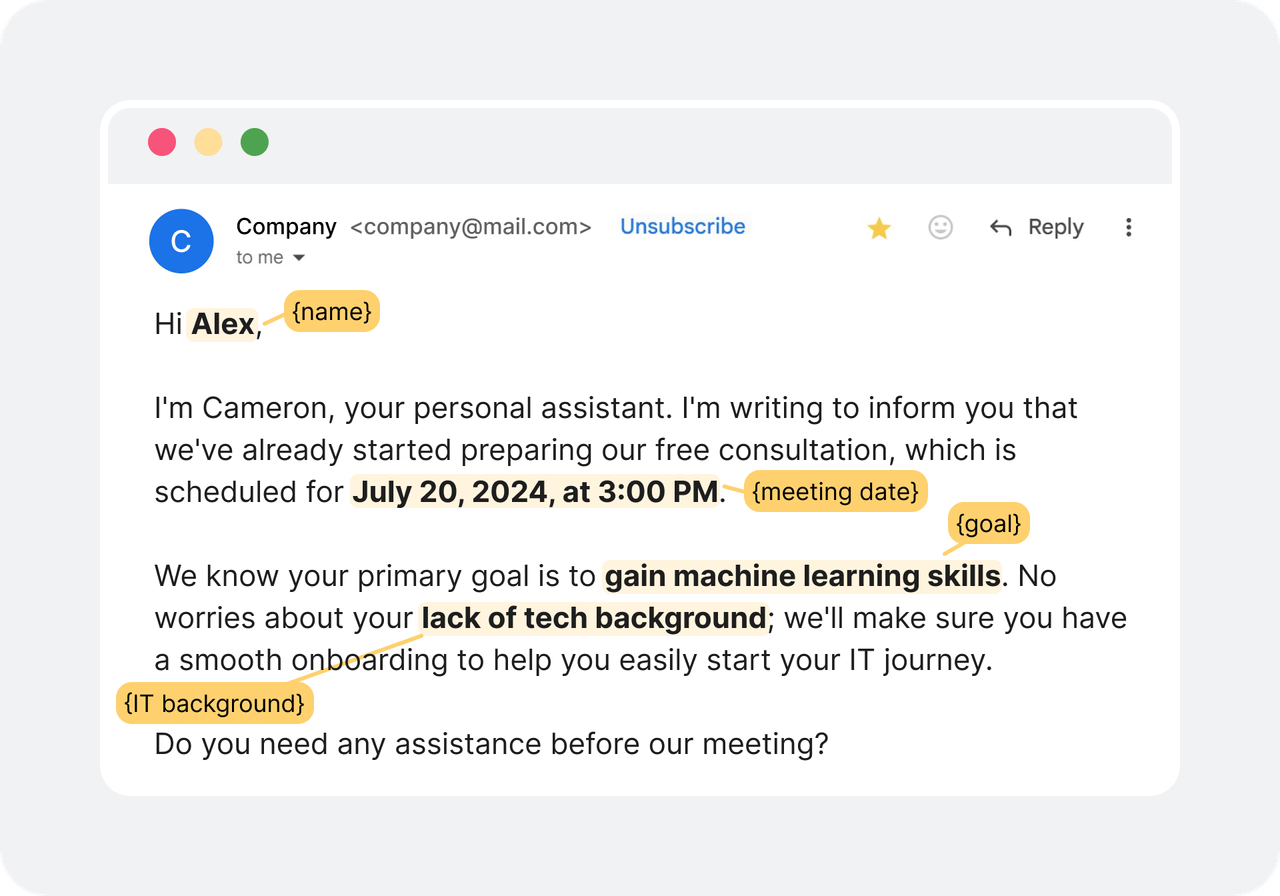
Finally, Dashly’s personalized nurturing emails underscore the value of tailored communication. By delivering content that resonates with lead interests and needs, Dashly keeps prospects engaged and guides them towards conversion. This strategy ensures that leads remain interested and informed, ultimately driving successful outcomes in the sales funnel.
Dashly’s approach is a standout inbound example of utilizing AI and automation to enhance sales processes. By integrating cutting-edge technology into their sales funnel, Dashly not only attracts but successfully engages and converts leads.
The Dashly way emphasizes the importance of leveraging AI to handle routine tasks, allowing teams to focus on building meaningful relationships with prospects. Incorporate these strategies to optimize your own sales funnel processes and drive growth.
Double your SaaS sales funnel conversion with Dashly AI
⭐ Engage prospects with conversational quiz
⭐ Segment them with data‑driven scoring
⭐ Respond and bring top leads to sales with AI outreach
Sales funnel of Dropbox
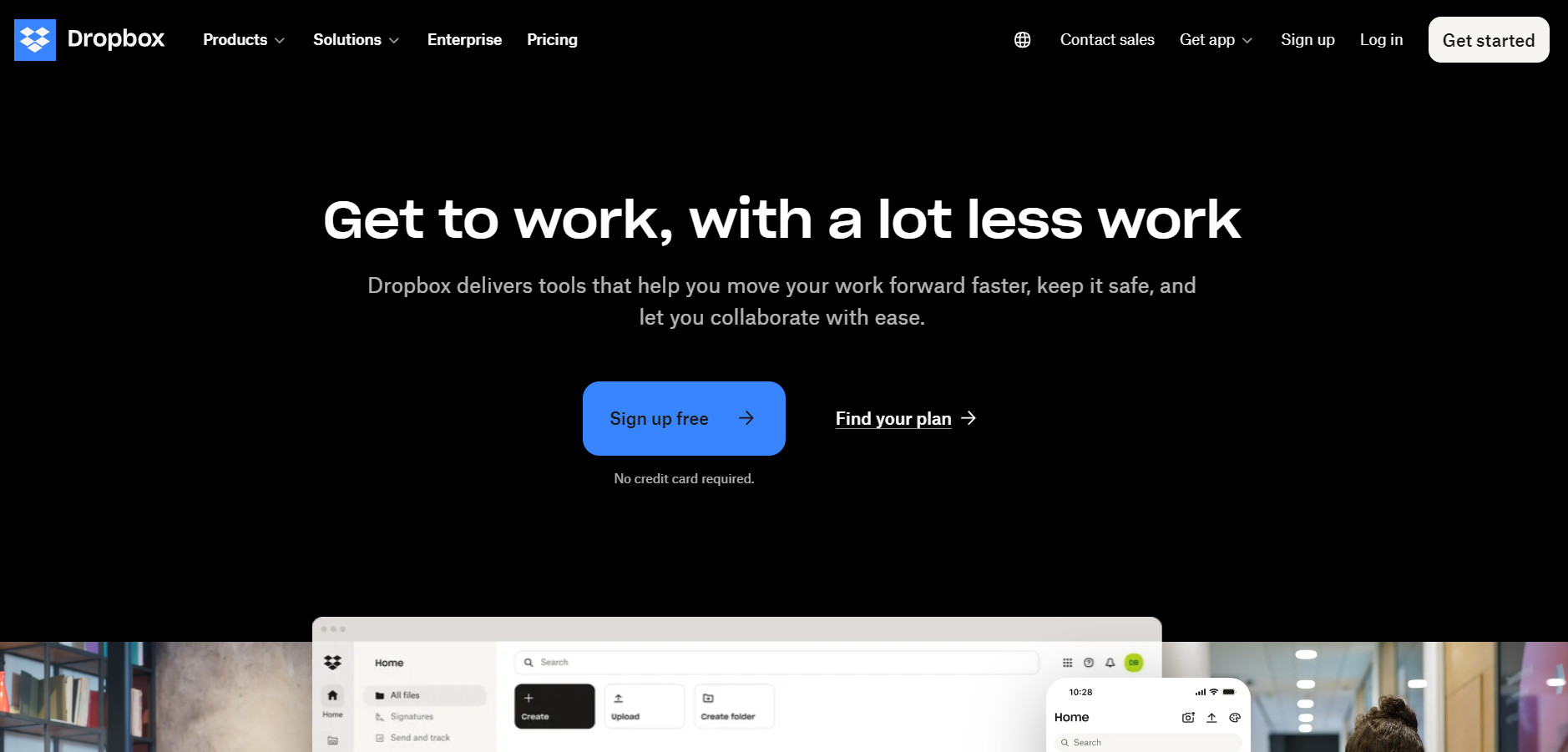
Say hello to Dropbox, the pioneer of cloud storage and file sharing that has revolutionized the way individuals and businesses manage and share their files.
With its user-friendly platform, Dropbox offers seamless work across numerous devices, making it an essential tool for both professional and personal life. Thanks to its viral strategies, Dropbox stands as a compelling sales funnel example in the SaaS industry.
Let’s explore how Dropbox has crafted an effective example sales funnel and what you can learn from it.
Funnel steps
- Discovery through word of mouth and SEO: Dropbox uses a powerful combination of word-of-mouth marketing and search engine optimization to build awareness. Happy users naturally share their experiences, creating organic buzz and expanding its user base. Coupled with a strategic SEO approach, Dropbox captures the attention of users searching for reliable, efficient cloud storage solutions. This approach ensures a steady stream of potential leads eager to explore what Dropbox has to offer.
- Initial engagement with an intuitive landing page: Upon arriving at the Dropbox website, visitors are greeted by a clean and intuitive landing page that highlights the core benefits of using Dropbox. The minimalistic design encourages quick exploration and sign-up, reflecting the seamless experience Dropbox promises.
- Conversion through freemium model: Central to Dropbox’s strategy is its effective freemium model. Users are able to start with a free account, giving them the opportunity to experience Dropbox’s core offerings without credit card details. As users grow comfortable and require more storage or advanced features, they are prompted to upgrade, gently pushing them further down the sales funnel.
- Viral growth via referral program: Finally coming to the best part. Dropbox’s referral program is pretty much a legend in referral marketing now. By offering additional storage space as an incentive for inviting friends and colleagues, Dropbox not only retains its existing user base but also attracts new users in a mutually beneficial cycle. This strategy is key to the platform’s viral growth and an integral part of this sales funnel example.
- Loyalty through exceptional seamless integration and performance: Once onboard, Dropbox maintains user loyalty through seamless integration across all devices and platforms. The consistent and reliable performance of the platform ensures that users remain satisfied and see Dropbox as indispensable, reducing churn and reinforcing long-term engagement.
Why this example works
Dropbox’s sales funnel is a treasure trove of insights for anyone looking to create a successful sales journey.
First, prioritize user experience and word-of-mouth marketing to drive discovery and engagement. By encouraging satisfied users to share their experiences, Dropbox harnesses organic growth while reinforcing their brand’s reliability and value.
An intuitive landing page that clearly communicates the platform’s core benefits is essential. Dropbox’s clear messaging and user-friendly design help reduce friction and make it easy for users to understand and embrace the platform. Translating this simplicity into your own conversion paths can lead to better user engagement.
The freemium model. Offering a valuable service for free lowers the barrier to entry and encourages widespread adoption. As users become more comfortable with the service and recognize its value, they become more inclined to purchase premium features, boosting conversion rates.
Dropbox’s referral program exemplifies how to leverage existing users for viral growth. By rewarding users for inviting others, Dropbox expands its user base effectively and cost-efficiently. Implementing a similar program in your own funnel could dramatically increase user acquisition and engagement. Think if there’s something you can expand user’s limits if they bring a referral (money also works as a great incentive 😉).
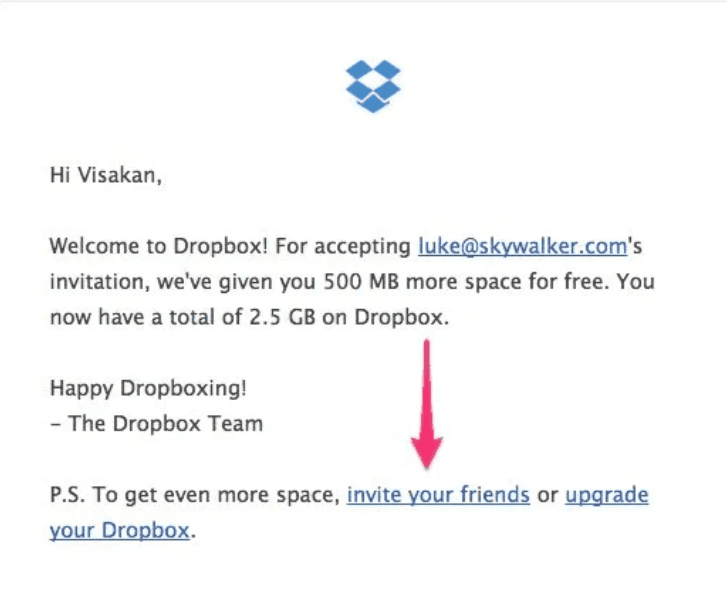
Finally, prioritize seamless work and performance to cultivate loyalty. Dropbox ensures that the user experience is consistently reliable across devices, reinforcing the platform as an indispensable tool. At the end of the day, it’s the product’s quality that keeps users satisfied and loyal.
Dropbox’s approach showcases a compelling example sales funnel that blends simplicity, strategic incentives, and seamless experience.
By integrating these strategies into your own sales funnel, you can create an engaging and effective journey that attracts and retains users. The Dropbox way highlights the power of simplicity, user-centric design, and viral growth in creating a successful sales strategy.
Read also: Top 15 Free Sales Funnel Software Options to Kickstart Your Funnel
Sales funnel of Grammarly

Next is Grammarly, the AI-powered writing assistant that’s transforming how we communicate.
Grammarly offers tools that help users write clearly, effectively, and error-free. It simplifies writing by providing real-time suggestions and corrections. It’s become an essential tool for students, professionals, and anyone eager to improve their writing. This article was also written under Grammarly’s careful watch, no one’s safe from typos and wordy sentences 😅
Now, let’s explore this sales funnel example to see how they attract and convert users.
Funnel steps
- Awareness through content marketing and SEO: Grammarly excels in attracting leads through robust content marketing and SEO. Their blog offers writing tips, grammar guides, and more, drawing in users seeking writing assistance. High search engine rankings ensure they capture attention and drive traffic to their website.
- Engagement with a strong value proposition: Once on their site, visitors encounter Grammarly’s compelling value proposition. Clear messaging outlines the benefits, encouraging signups. The site design is user-friendly, making it easy for visitors to understand what Grammarly offers.
- Conversion via a freemium model: Grammarly’s freemium model is key to conversion. Users can start for free, benefitting from basic writing corrections. As they recognize the tool’s value, many opt to upgrade to the premium version for advanced features. And Grammarly pitches you an upgrade smoothly. While you look through a list of corrections, it offers to see more with an upgraded plan.
- Expansion through browser extensions and integrations: Grammarly expands its reach by offering browser extensions and integrations with common platforms. This seamless functionality enhances user experience, and facilitates decision-making. It’s much easier to install a browser extension than figure out an app.
- Retention with personalized insights and weekly reports: Grammarly deepens user engagement by providing personalized insights and weekly performance reports. These features encourage continuous use and satisfaction, reducing churn.
Key takeaways for your sales
Grammarly’s funnel is a masterclass in leveraging content and simplicity to drive growth.
First, focus on content marketing. Sorry, for coming back to it again and again! By creating valuable and relevant content, you can draw a steady stream of organic traffic. This strategy helps Grammarly be viewed not just as a product, but as a resource for users seeking to improve their writing skills.
Grammarly’s clear value proposition is another effective strategy. Right from the start, they communicate what makes their tool indispensable, enticing users to explore further. This clarity helps in capturing interest quickly and effectively.
The freemium model is central to Grammarly’s success. As free users experience the benefits, many are naturally inclined to upgrade for more advanced capabilities. This incremental value proposition aids in conversion and user retention.
Another standout practice is Grammarly’s browser extensions and integrations. By meeting users where they are — whether in emails, documents, or social media — Grammarly ensures its utility is constantly reinforced. This seamless integration into daily tasks keeps the tool top-of-mind and indispensable. If your product can’t work as an extension, look at your integrations. Is your product easy enough to implement and fit in the existing tool kit of your users?
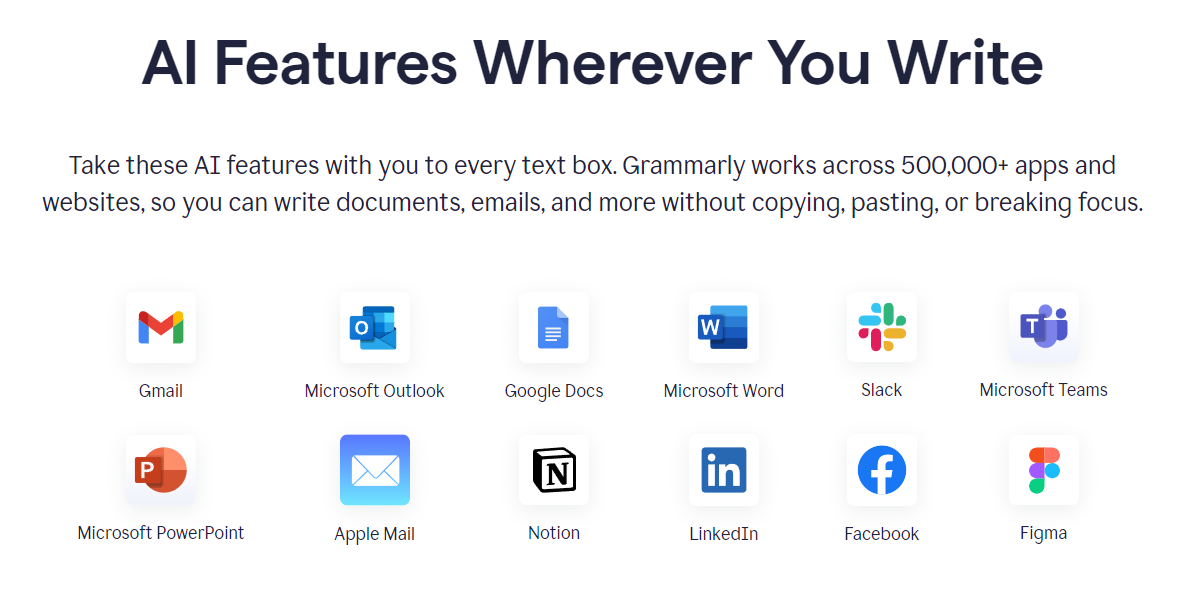
Finally, the use of personalized insights and performance reports is a clever way to enhance user experience. By providing tailored feedback and tracking improvements, Grammarly keeps users engaged and invested in their progress. This strategy not only improves retention but also fosters loyalty.
Grammarly sets a high bar as a sales funnel example in the SaaS space. Through content-driven lead generation, clear messaging, a strategic freemium approach, and ongoing user engagement, they’ve crafted an efficient and effective sales funnel.
Sales funnel of Zendesk
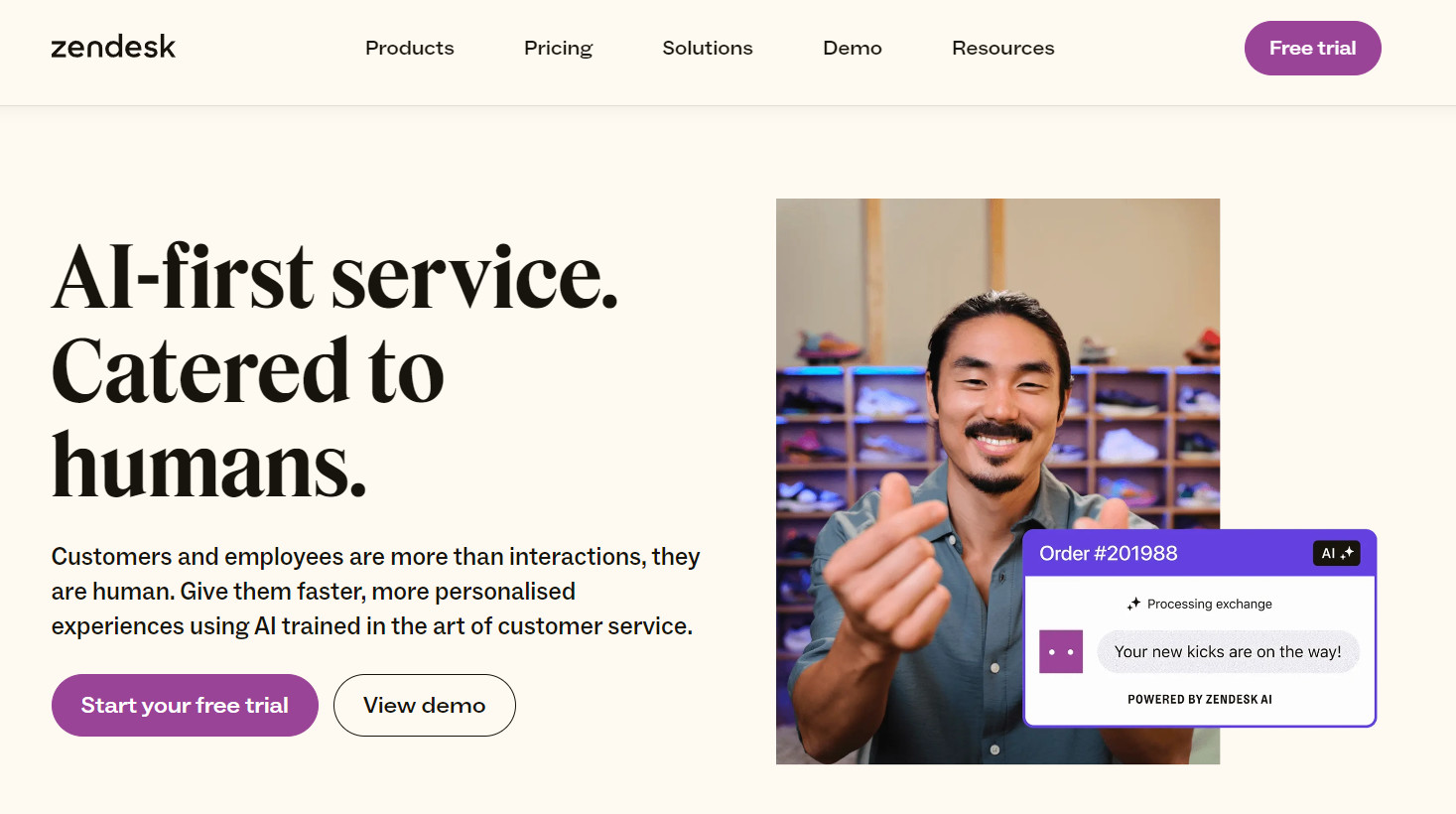
Zendesk is a leader in customer service and support software. Its tools help enhance customer relationships through efficient support, sales, and engagement solutions.
Everything to help you provide better service experiences, improve customer satisfaction, and build strong, long-term relationships.
Let’s take a closer look at this example of a sales funnel that powers Zendesk’s continuous growth and engagement.
Funnel steps
- Awareness through digital campaigns and partnerships: Zendesk employs a multi-faceted strategy to build awareness and attract potential leads. They utilize digital marketing campaigns, including online ads and content marketing, to reach a broad audience. Additionally, strategic partnerships and collaborations with industry leaders help increase Zendesk’s visibility in the marketplace.
- Engagement with informative product pages and educational resources: On Zendesk’s website, visitors see a ton of informative resources. The website features detailed product pages that delve into specific features, benefits, and use cases. By providing educational content such as whitepapers, guides, and webinars, Zendesk educates potential customers about their offerings and builds credibility.
- Conversion with free trials and live demos: To encourage conversion, Zendesk offers free trials and live demos of their software. These incentives allow potential customers to experience the platform first-hand or with expert help.
- Lead nurturing through personalized follow-ups: After capturing leads, Zendesk employs personalized follow-up communications to deepen engagement and nurture relationships. Customized emails and targeted offers are shared with prospects to address their specific needs and concerns. This personalized approach helps maintain interest and moves prospects further down the sales funnel.
- Retention and expansion via comprehensive support and community building: Zendesk maintains user engagement and satisfaction through exceptional customer support and community-building initiatives. By offering a robust help center, live support, and training, Zendesk ensures users continue to get value from their products. This commitment to top-notch customer service strengthens users’ loyalty and encourages expansion within existing accounts.
Why this example works
Zendesk’s sales funnel presents a masterclass in creating a holistic and user-centric customer journey.
The first idea you can take is building awareness through digital campaigns and strategic partnerships. By leveraging a variety of marketing channels, Zendesk maximizes its reach and effectively captures the interest of potential customers. Try to see other products not just as competitors but partners too. Via seamless integration or cross promotion, you can give users another reason to choose your product.
The use of informative product pages and educational resources is another effective tactic. By providing detailed information and educational content, Zendesk helps prospects understand the value of their offerings, reducing hesitation and building credibility. This approach not only engages visitors but also positions Zendesk as a trusted authority in customer support.
Free trials and live demos are central to Zendesk’s conversion strategy. Allowing prospects to experience the platform without commitment enables them to gain hands-on experience and recognize its potential.
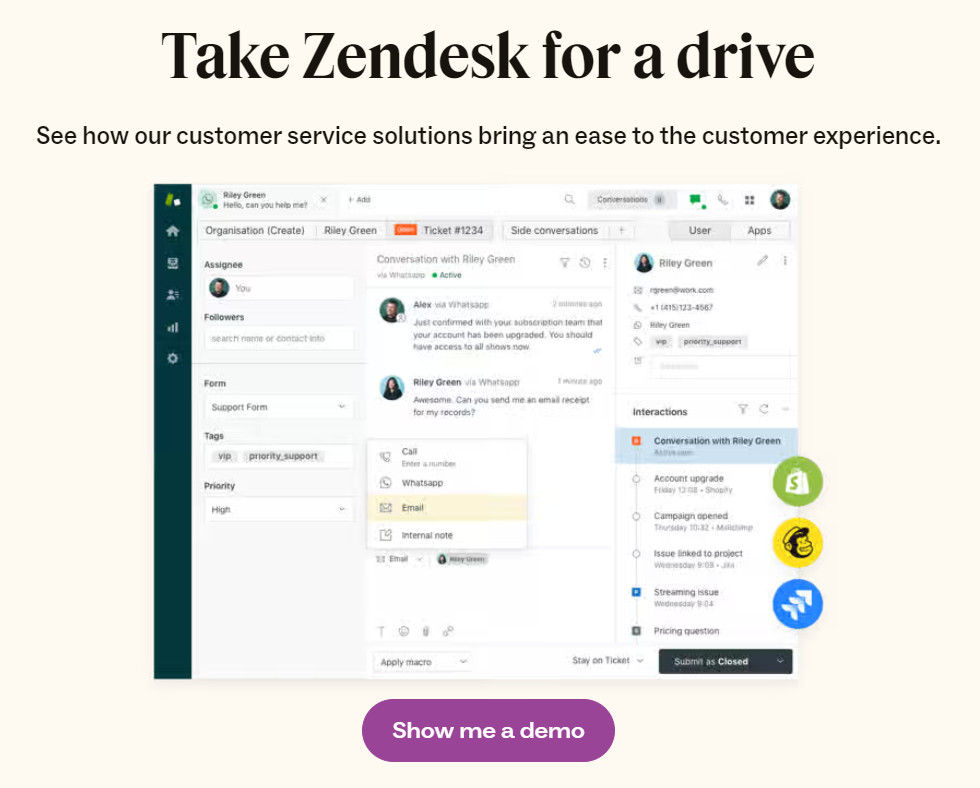
Personalized follow-ups play a significant role in nurturing leads. By tailoring communication to the specific needs and interests of each prospect, Zendesk ensures a smooth and personalized nurturing process. And when your demo with a prospect is over, don’t hesitate to send them a follow-up. Give them a recap of the call, suggestions on further steps, provide useful materials.
Exceptional customer support and community building are key components of Zendesk’s retention strategy. By offering ongoing support, resources, and engagement opportunities, Zendesk fosters a sense of belonging and loyalty among their users. This commitment to customer success helps minimize churn and encourages long-term satisfaction and advocacy.
Zendesk’s approach is another effective example of a sales funnel that combines digital outreach, informative engagement, and exceptional support to drive success.
By integrating these strategies into your own sales funnel, you can create a seamless experience that not only attracts but retains customers.
Sales funnel of Mailchimp
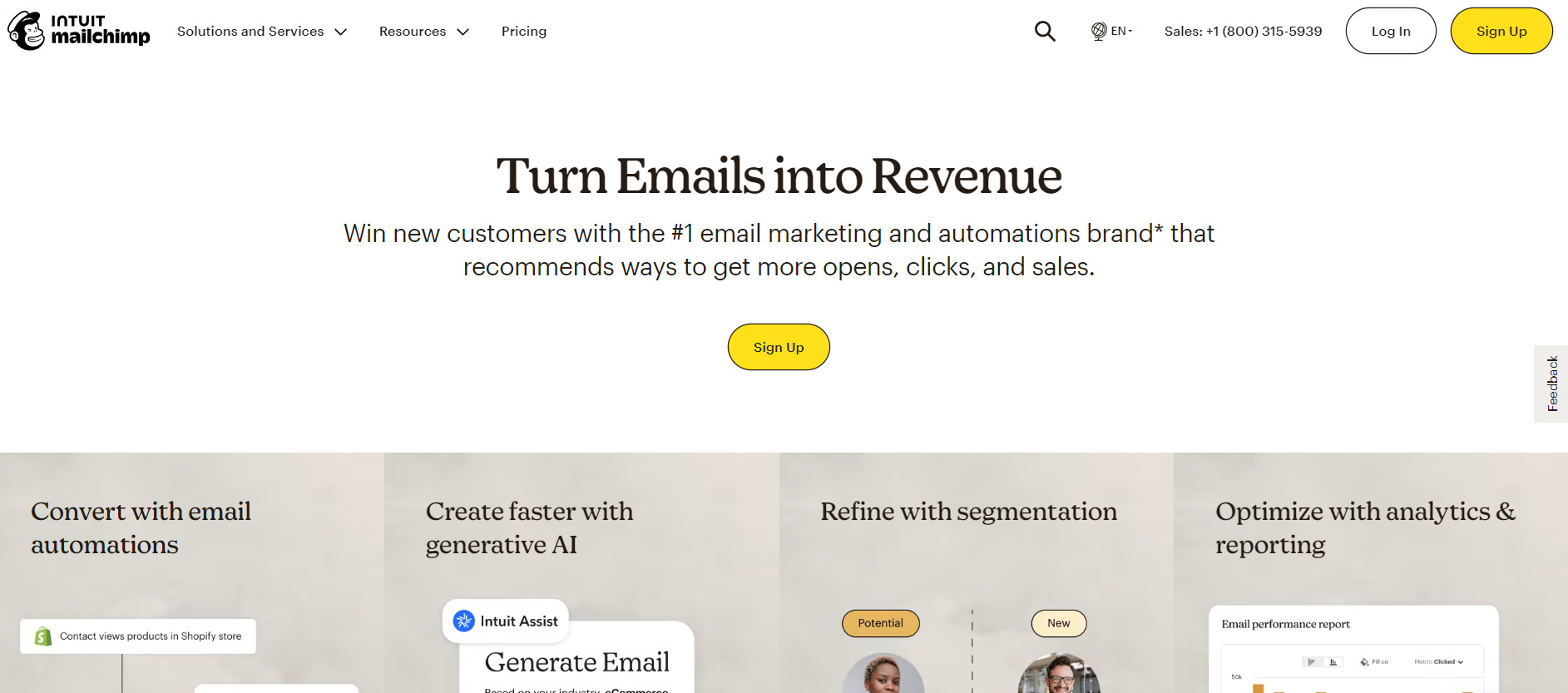
Mailchimp is a comprehensive platform for effective email marketing.
Known for its all-in-one marketing suite, Mailchimp empowers businesses to cultivate meaningful relationships with their audiences through innovative email campaigns and marketing automation.
Let’s dig into their sales funnel to uncover what makes it such a compelling example.
Funnel steps
- Attraction through content and social media: Mailchimp harnesses the power of content marketing and social media to attract potential leads. Their blog is filled with marketing tips and insights, while their active social media presence engages users and drives them to the website.
- Engagement with easy-to-use landing pages: Mailchimp puts a lot of effort into making clear user-friendly landing pages where visitors can learn more about the product’s features and benefits. The intuitive design encourages exploration and simplifies the decision-making process. And their results in numbers (ROI, number of users, generated revenue) draw attention and build prospects’ trust.
- Conversion with a freemium model: Mailchimp effectively utilizes a freemium model. Users can get started with basic features with pretty rich functionality. This is the way for Mailchimp to help new marketers achieve first results, thus giving newcomers an opportunity and lowering barriers to entry.
- Nurturing through custom onboarding and resources: New users receive custom onboarding experiences. Mailchimp provides step-by-step guides, tutorials, and support, ensuring that users can maximize the platform’s capabilities.
- Retention and upselling via automation and analytics: Mailchimp keeps users engaged with advanced automation and analytics tools. These features enhance user experience and provide insights for growing customer engagement, encouraging upgrades.
Why this example works
Mailchimp’s sales funnel can serve as an example in numerous ways.
First, focus on creating valuable content and maintaining an active social media presence to drive awareness. By engaging with potential customers through insightful blog posts and social media interactions, you can expand your reach and attract a steady flow of organic traffic to your site.
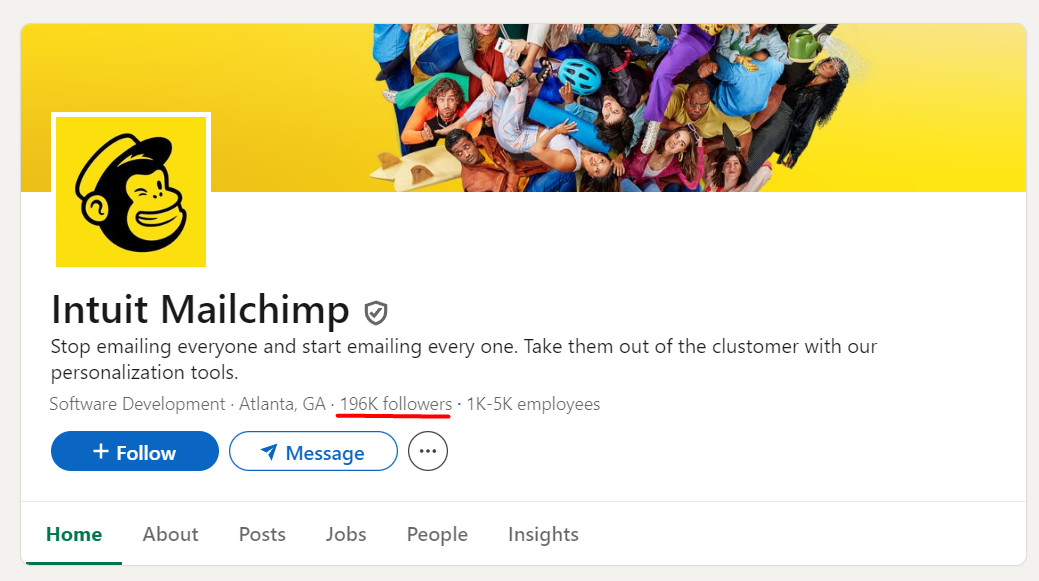
Look at all the content you have by now, can you repurpose it to distribute to as many channels as possible?
A clear and intuitive website is another crucial element. Mailchimp’s easy-to-navigate landing pages make it simple for users to explore and understand the benefits of their services. Ensuring your website is user-friendly helps reduce friction and encourages deeper exploration.
The freemium model is central to Mailchimp’s conversion strategy. Offering free access and supporting the audience of beginners really contributes to Mailchimp’s reputation and builds trust of the community around it. As users get first tangible results thanks to the platform, they’re more likely to upgrade to a paid plan.
Mailchimp excels in nurturing new users through comprehensive onboarding and resources. By providing personalized guidance and support, they ensure users can fully leverage their tools, increasing satisfaction and reducing churn. This personalized onboarding is an excellent practice to implement in your own funnel.
Finally, providing value and adding a bit more on top to excel users’ expectations is the key. For Mailchimp, it’s advanced automation and analytics that help retain users and encourage upgrades. These tools not only enhance user experience but also provide actionable insights that help users see the value in expanding their usage of Mailchimp’s services.
What can you do to enhance user experience?
Mailchimp’s sales funnel provides insightful sales funnel ideas for those looking to improve engagement and conversion.
By emphasizing content, user experience, and ongoing support, they demonstrate how a well-rounded strategy can drive both acquisition and retention.
Apply these lessons to craft a sales funnel that not only attracts but also keeps users engaged and loyal.
Funnel example of HelpScout
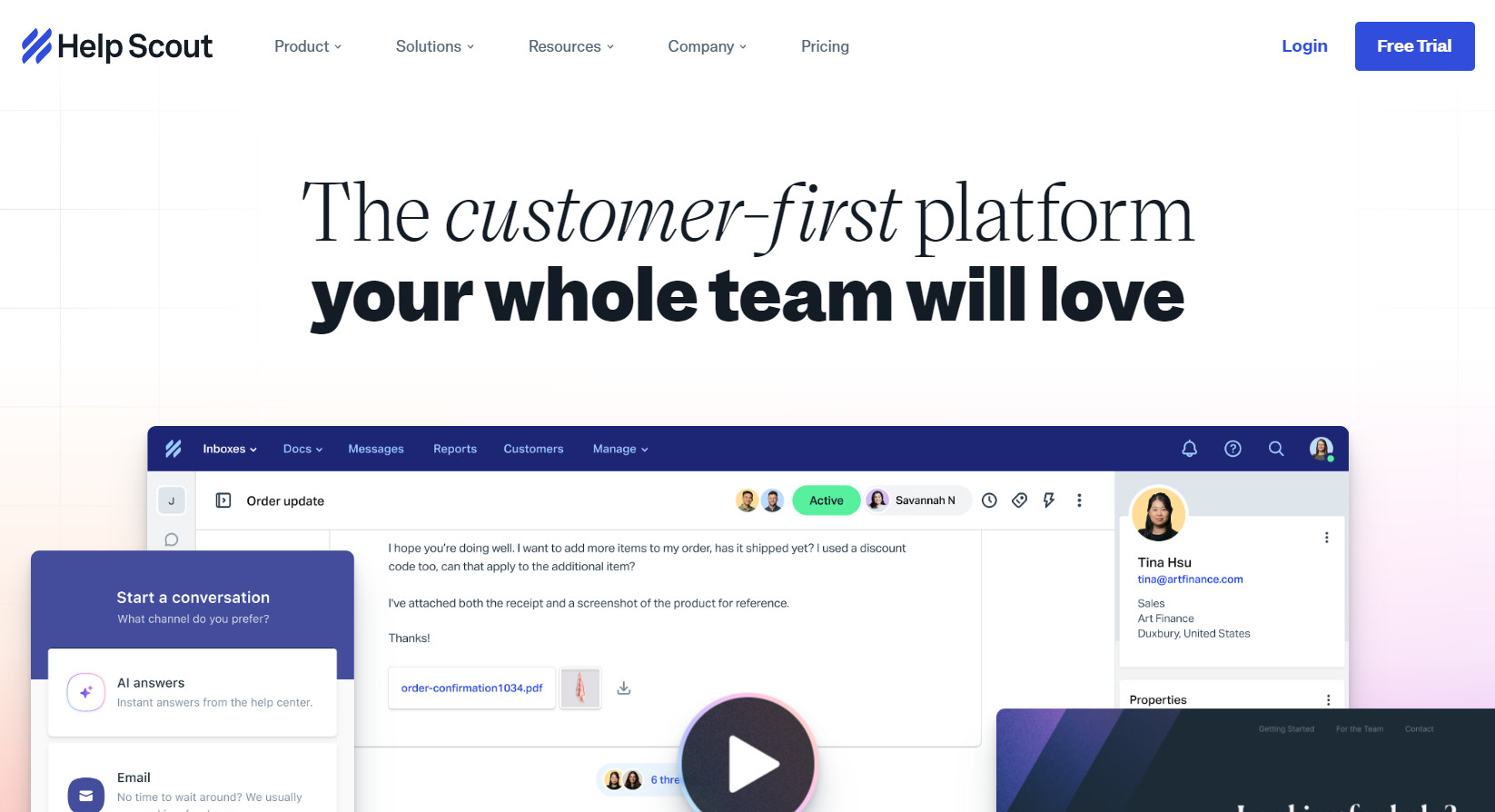
Help Scout provides businesses with powerful help desk software designed to enhance customer experience, streamline team collaboration, and offer exceptional support services.
It has become an essential partner for businesses aiming to improve customer satisfaction and loyalty.
Let’s dive into this sales funnel sample to understand how Help Scout attracts and converts users through its well-crafted approach.
Funnel steps
- Awareness through content and SEO: Help Scout effectively attracts potential leads through educational content and a strong SEO strategy. Their blog is filled with insightful articles, guides, and resources on improving customer support and service. This content positions Help Scout as a thought leader in the field, drawing in visitors who are eager to enhance their service capabilities. By optimizing their content for search engines, Help Scout ensures they capture attention from prospects searching for customer support solutions.
- Engagement with interactive product demos and resources: Visitors to the Help Scout website are greeted with interactive product demos and comprehensive resources. Pre-recorded demos are a great tactic if you invest in a self-service funnel and want to present the key features of your solution. Again, show your achievements in numbers and real-world examples, proving your effectiveness to prospects straightaway.
- Conversion through free trials: A key component of Help Scout’s sales funnel is the offering of free trials and they’re consistent in their CTAs, offering free trial on all pages of the website.
- Nurturing via guided onboarding: Once leads have signed up for a trial, Help Scout welcomes them with a guided onboarding experience. Personalized tutorials and support ensure users can quickly adapt to the platform, maximizing its potential and fostering deeper engagement. This nurturing process is crucial in maintaining momentum and guiding prospects smoothly through the sales funnel.
- Retention through exceptional customer support and community engagement: Help Scout excels in delivering outstanding customer support, reinforcing trust and satisfaction among users. They offer comprehensive help centers, community forums, and responsive support solutions that keep users engaged and satisfied.
Key takeaways for your sales
Help Scout’s sales funnel provides valuable insights into creating an effective customer journey. Firstly, focus on creating valuable content and optimizing it for search engines to drive awareness. By sharing practical insights and industry knowledge, Help Scout positions itself as both a resource and a solution for potential customers seeking to improve their customer support services.
Interactive product demos are an effective tactic. By allowing prospects to explore the software’s features and benefits firsthand, Help Scout builds interest and understanding, making it easier for visitors to envision how the tool fits their needs. This immersive introduction helps reduce hesitation and encourages deeper engagement.
Consistent offering of free trials is central to Help Scout’s conversion strategy. Allowing prospects to try the platform risk-free enables them to see its full capabilities and value. And make sure to keep a clear CTA on all pages to make your CJM coherent and avoid any leaks in the funnel. Don’t hesitate to share numbers! Tell about results your customers achieve and how you help them.

Personalized onboarding is crucial for nurturing new users. Help Scout’s guided onboarding process ensures that users can quickly adapt and fully leverage the platform’s features. By providing tailored guidance and support, Help Scout enhances user satisfaction and retention, reducing churn and promoting long-term loyalty.
Finally, exceptional customer support is a key element of Help Scout’s retention strategy. By offering responsive and helpful support, along with comprehensive resources and community engagement, Help Scout fosters trust and loyalty. This consistent commitment to customer success ensures that users continue to derive value from the service and remain engaged over time.
Help Scout’s approach exemplifies a well-rounded sales funnel sample that blends content, engagement, and support to drive success.
By integrating these strategies into your own sales funnel, you can create a seamless and rewarding experience that not only attracts but retains customers. The Help Scout way underscores the importance of clarity, user experience, and ongoing support in nurturing long-lasting customer relationships.
Funnel example of Slack
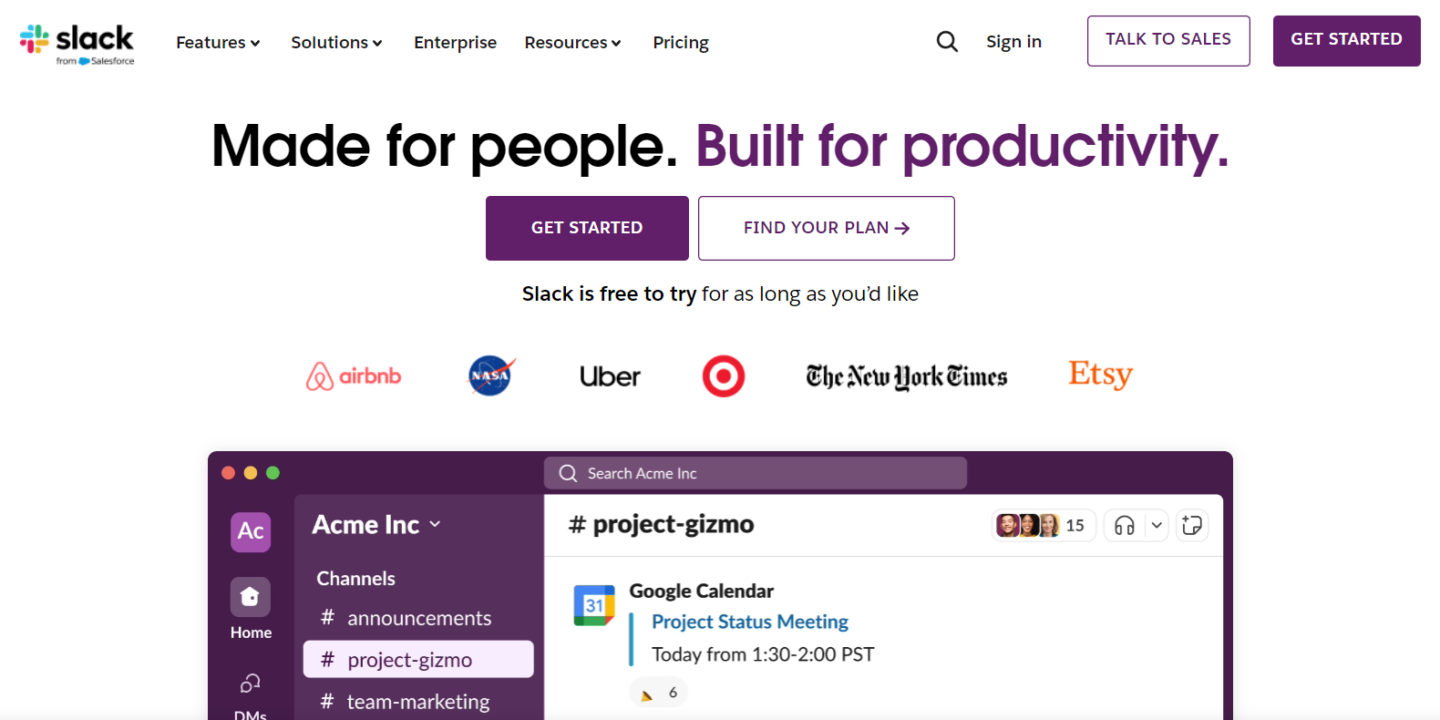
There’s no doubt that Slack has transformed workplace communication. It offers a dynamic messaging app for teams, designed to streamline communication and enhance collaboration across organizations.
Let’s explore the sales funnel that fuels Slack’s growth and engagement.
Funnel steps
- Awareness through word of mouth and digital marketing: Slack capitalizes on word-of-mouth referrals and digital marketing to attract new users. Engaging online campaigns and a strong presence in tech communities highlight the platform’s capabilities and reach potential leads. Besides, Slack made itself an integral part of working communities.
- Conversion via freemium model and trials: Slack employs a freemium model, allowing users to get started for free. But just like Grammarly Slack gently pushes users to upgrade offering additional features and extended limits. Prospects can also opt for trials of premium features to explore enhanced capabilities.
- Nurturing with integration and community support: Slack nurtures its users by offering a range of integrations and strong community support. These seamlessly enhance user experience, making it easier for teams to incorporate Slack into their daily workflows.
- Retention through continuous updates and customer feedback: Slack maintains user engagement by regularly updating features based on customer feedback. This iterative process ensures the platform stays relevant and addresses user needs effectively.
Read also:
Sales Funnel Statistics: Your Ultimate Guide to Boosting Your Company Growth
Master the Inverted Sales Funnel: A 7-Step Guide to Grow Conversions
Why these conversion examples work
Slack’s funnel examples provide a wealth of insights for crafting a successful sales journey.
Firstly, prioritize word-of-mouth marketing and maintain a solid online presence to expand reach. By actively engaging with tech communities and leveraging user recommendations, Slack effectively attracts a steady stream of new users.
An intuitive interface and clear feature presentation are other key elements. Slack ensures that users can quickly understand and navigate the platform, reducing friction and encouraging deeper exploration. Providing easy access to key features builds confidence and interest among potential customers.
Smooth onboarding to new features via short text hints is also a great way to get users familiar with the platform or introduce them to new features.
The freemium model is central to Slack’s sales funnel. Offering a basic version of the platform for free allows users to experience its value without commitment. As they explore the platform and its benefits, they’re more likely to consider upgrading for additional features.
Integrations play a crucial role in Slack’s nurturing strategy. By offering seamless connections with other tools, Slack ensures users experience a cohesive workflow, enhancing satisfaction and loyalty. This integration-friendly approach is a powerful way to increase user engagement and retention.
Finally, Slack’s commitment to continuous improvement underscores its retention strategy. By actively incorporating user feedback and regularly updating features, Slack remains responsive to customer needs. This iterative process ensures the platform evolves alongside its users, maintaining long-term relevance and value.

Slack’s approach is a compelling sales funnel strategy worth emulating. By combining user-centric design, strategic marketing, and ongoing engagement, Slack creates a cohesive and rewarding experience for its users.
Integrate these lessons into your own sales funnel, and you’ll be well on your way to building a dynamic, user-friendly journey that captivates and retains customers.
The Slack way is all about adaptability, engagement, and community — a winning formula for success in any funnel.
Funnel example of Crazy Egg
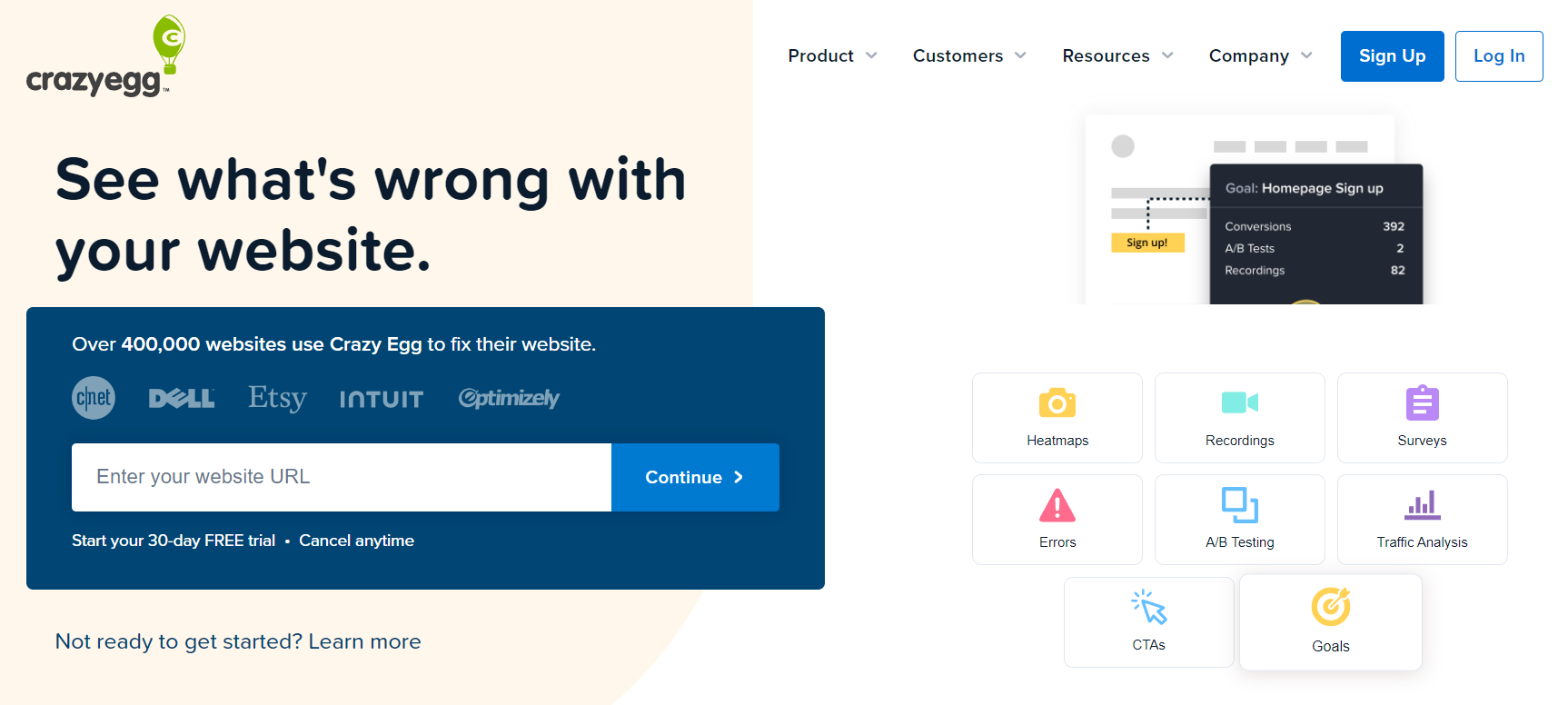
The final player on our list is Crazy Egg. It’s an analytics platform that lets you visualize user behavior.
Crazy Egg offers tools to help businesses understand how visitors interact with their websites through heatmaps, scroll maps, and user recordings. By providing insights into user behavior, Crazy Egg empowers companies to make data-driven decisions to improve website performance and user experience.
Let’s delve into the sales funnel that drives Crazy Egg’s success.
Funnel steps
Awareness through targeted content and SEO: Crazy Egg attracts potential leads through targeted content and a strong SEO strategy. Informative blog posts and guides on improving website functionality draw in visitors seeking to enhance their digital presence.
Engagement with simplicity and comprehensive design: Once on the site, visitors see just one screen. On it, Crazy Egg offers to see what’s wrong with the user’s website. No fooling around, they offer value straightaway. In the clearest way. Crazy Egg cherishes the user’s attention and focuses it on a single simple action — sign-up. You also see the main features Crazy Egg offers, notorious users of the platform and a CTA.
Conversion through value: Crazy Egg lets visitors know what the platform is about on the first screen. They help see and analyze how your website can be improved. And it’s catching. It doesn’t waste your time and offers instant value. That helps convert.
Nurturing with personalized follow-ups: After capturing leads, Crazy Egg nurtures them with personalized follow-up emails. By sharing useful tips and resources, they keep prospects engaged and assist them in getting the most from their trial experience.
Retention through ongoing support and resources: Crazy Egg ensures user satisfaction by providing continuous support and a wealth of resources. This commitment helps users leverage the platform effectively, enhancing retention and loyalty.
Key takeaways for your sales
Crazy Egg’s sales funnel offers valuable lessons for creating a user-centric sales journey.
Begin by prioritizing targeted content and optimizing for search engines to drive awareness. By sharing practical advice and industry insights, Crazy Egg positions itself as both a resource and solution for potential customers.
Focus on value from the first interaction. The use of clear headlines without long detailed explanations is an effective approach. By clearly illustrating how the platform benefits users, Crazy Egg builds trust and credibility, reducing hesitation and encouraging exploration.

Offering free trials is central to Crazy Egg’s conversion strategy. Allowing prospects to try the platform without financial commitment enables them to experience its full capabilities, which in turn boosts conversion rates.
Personalized follow-ups play a significant role in nurturing leads. By engaging prospects with tailored communication and useful resources, Crazy Egg ensures that users stay engaged and informed throughout their trial period. This personal touch enhances the overall user experience and guides prospects down the funnel.
Finally, continuous support and resources are key to Crazy Egg’s retention strategy. By offering responsive support and a wealth of materials to help users maximize their experience, Crazy Egg fosters long-term loyalty and customer satisfaction.
Crazy Egg’s approach to funnel management offers some compelling examples of user engagement and support. By focusing on targeted content, clear communication, and ongoing assistance, they create a seamless and effective sales journey.
Utilize these lessons to optimize your own sales funnel, and you’ll be well on your way to crafting a dynamic experience that captivates and retains customers.
Funnel example of Semrush

Let’s talk about Semrush, a giant in the SEO world. In simple terms? They’re the people who help your website show up when someone googles what you offer.
And they’re not just good at it. They own it.
First, they know how to get traffic. Tons of it. But more importantly, they know what to do with those visitors. Semrush turns clicks into leads — and leads into customers.
One of their secret weapons? Content.
Back in the day, it was ebooks. Now, it’s guides, reports, insights. Still packed with expert knowledge, just in more formats. And here’s the kicker: each piece of content is a lead magnet. To get it, you hand over your name, email, maybe even a phone number. Boom you’re in their sales funnel.
That content isn’t just helpful. It’s strategic. It solves real problems, builds trust, and moves people from “just browsing” to “tell me more.”
How to steal this move for your own funnel:
- Take what you know your best tips, how-to guides, cheat sheets;
- Save it as a PDF;
- Set up a simple form to grab names and emails;
- Send the doc via email or link to a landing page with the download.
It’s a win-win: your lead gets value, and you get a foot in the door. Welcome to the funnel.
Funnel steps
Awareness: Semrush attracts potential customers through various channels such as SEO-optimized blog posts, social media content, webinars, and free tools. These resources aim to educate users about digital marketing challenges and introduce Semrush’s solutions.
Interest: Once users are aware of Semrush, they are encouraged to engage further by exploring in-depth content like case studies, whitepapers, and product comparison guides. This stage focuses on nurturing leads by providing valuable information that addresses their specific needs.
Consideration: At this point, prospects are evaluating Semrush’s offerings against competitors. Semrush facilitates this by offering free trials, detailed product demos, and personalized consultations, allowing users to experience the platform’s capabilities firsthand.
Decision: Ready-to-buy customers are guided towards making a purchase through clear calls-to-action, transparent pricing information, and testimonials from satisfied clients. Semrush ensures that the transition from prospect to customer is seamless and informed.
Retention and Advocacy: Post-purchase, Semrush focuses on customer success by providing continuous support, educational resources, and opportunities for feedback. Satisfied customers are encouraged to become brand advocates, sharing their positive experiences and contributing to Semrush’s reputation.
Key takeaways for your sales
- Give value first
Semrush nails the top of the funnel with free tools, SEO-optimized content, and super practical resources. They don’t push the product right away, they help. And that’s the move. For your SaaS, start by solving real problems with blog posts, templates, or mini-tools. Show up when people search, and give them something useful. That’s how you earn attention (and trust).
- Turn visitors into leads with content that matters.
Once someone’s on the site, Semrush offers lead magnets reports, guides, industry insights. But there’s a catch: you’ve got to drop your email to get them. Classic and effective. For your SaaS, don’t overthink it. Package your best advice into a PDF or a checklist, add a form, and boom you’ve got a lead. Just make sure the content is actually worth the click.
- Let people try before they buy.
Semrush makes it easy to explore the product. Free trials, product tours, no-pressure demos. The whole point? Let users see the value before committing. For your SaaS, make the trial smooth. Remove friction. Help users get that “oh wow, this works” moment fast. That’s what drives conversions.
- Build trust with proof.
Semrush doesn’t just say “we’re great”, they show it. Customer stories, case studies, and clear pricing do the heavy lifting. It makes buying feel safe. For your SaaS, the same rules apply. Show who’s using your product and how it helped them. Add reviews and case studies. Be clear about what it costs. No games.
- Keep the love going post-signup.
After someone signs up, Semrush doesn’t disappear. They support users with onboarding, resources, and helpful emails. The goal? Turn new users into loyal fans. Your SaaS should do this too. Great onboarding + great support = low churn and happy customers who stick around (and tell their friends).
- Track, test, tweak. Repeat.
Semrush is always learning. They test what works, watch what users do, and tweak the funnel nonstop. You should too. Keep an eye on what content drives signups, where users drop off in your trial, and what questions pop up in support. Use that info to improve each stage. Better funnel = more growth. Simple as that.
Final thoughts on funnel examples
In the competitive world of business, optimizing your sales funnel is not just a necessity; it’s a pathway to growth and improved customer interactions.
A well-structured sales funnel helps companies develop strategies that increase engagement, boost conversions, and secure customer loyalty. By analyzing successful funnel examples, businesses can identify potential pitfalls in their own processes and discover fresh ideas for experimentation.
I hope drawing inspiration from the diverse sales funnel examples in this article will help you refine your own strategies and unlock new opportunities for success.
Remember, the key to an effective funnel is continuous improvement and adaptation. As you implement changes, be sure to monitor results and adjust accordingly.
Wish you the best of luck with your experiments and hope to see your business grow faster than ever 🚀
May your efforts lead to a thriving sales funnel that not only meets but exceeds your goals. Keep innovating and pushing the boundaries of what’s possible!
Double your SaaS sales funnel metrics with Dashly AI
⭐ Engage prospects with conversational quiz
⭐ Segment them with data‑driven scoring
⭐ Respond and bring top leads to sales with AI outreach
FAQ
A sales funnel is a visual representation of the customer journey from awareness to purchase. It illustrates the stages prospects go through before becoming customers. Funnel examples typically include stages like awareness, interest, consideration, and conversion.
Sales funnels help businesses understand and streamline the process that converts leads into customers. By analyzing each stage, companies can identify bottlenecks and opportunities for improvement. Effective sales funnels lead to higher conversion rates and more efficient sales processes.
To optimize your sales funnel, start by analyzing each stage for weak points. Implement A/B testing to compare different strategies and refine your approach. Use funnel examples from successful companies to inspire ideas that can enhance your funnel’s effectiveness.
Key metrics include conversion rates at each stage, lead-to-customer ratios, and average deal size. Monitoring these metrics helps in understanding your funnel’s efficiency and effectiveness. Regularly reviewing these metrics ensures your sales funnel is optimized for success.
Successful sales funnel examples provide insights into effective strategies like content marketing, freemium models, and customer engagement techniques. These examples show how personalization, clear communication, and strategic incentives can lead to higher conversions and customer loyalty.
For SaaS companies, sales funnels often include stages like free trials and demos, which allow prospects to experience the product before committing. Funnel strategies often focus on nurturing leads and encouraging upgrades, making them especially relevant for subscription-based models.
By leveraging these insights and funnel examples, businesses can craft smooth, effective funnels that guide prospects seamlessly through the buying process. Understanding and optimizing each stage ensures a successful customer journey and boosts overall sales performance.
Read also:
- Mastering sales funnel analysis: step-by-step guide, tools, and examples
- Ultimate guide to an AI sales funnel: the best tips, tools and common mistakes to avoid


![La guía definitiva de growth marketing [explicada por un growth hacker]](https://www.dashly.io/blog/wp-content/uploads/2023/04/The-ultimate-guide-to-growth-marketing-explained-by-a-growth-hacker-720x317.png)

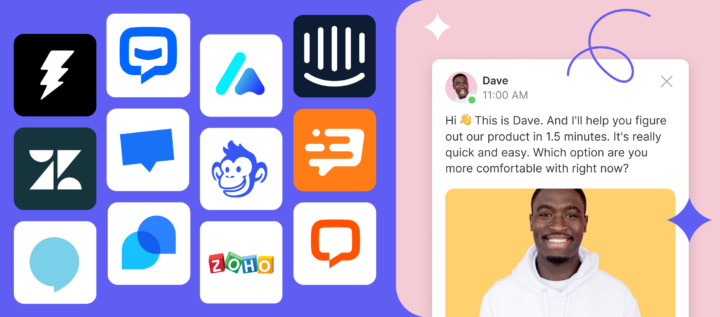
![4 steps as Chief Marketing Officer at a new company [Expert guide]](https://www.dashly.io/blog/wp-content/uploads/2022/10/4-steps-as-Chief-Marketing-Officer-at-a-new-company-Expert-guide-720x317.jpg)
